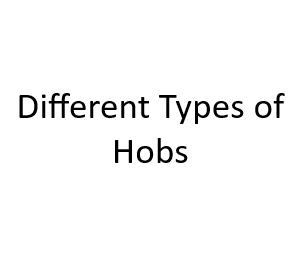In the realm of culinary innovation, a kitchen’s heart is undoubtedly its cooking appliances. Among these, the humble yet indispensable hob takes center stage. Hobs come in a variety of types, each catering to different cooking styles, preferences, and needs. In this comprehensive guide, we will discuss different types of hobs, exploring their features, benefits, and suitability for various cooking endeavors.
Gas Hobs: Traditional Charm and Precise Control
Gas hobs have long held a special place in kitchens around the world. Their classic appearance and instant heat control make them a favorite among professional chefs and home cooks alike. With a gas hob, you have the advantage of visual flame control, allowing you to adjust the heat precisely according to your cooking requirements. This type of hob is also suitable for a wide range of cookware, from cast iron to stainless steel.
Pros:
- Instant heat control and rapid temperature adjustment.
- Suitable for various types of cookware.
- Traditional cooking experience with visible flame.
Cons:
- Cleaning can be more intricate due to the burner design.
- Energy efficiency might be lower compared to some modern alternatives.
Induction Hobs: Cutting-Edge Efficiency and Safety
Induction hobs have revolutionized the way we cook by using electromagnetic technology to heat the cookware directly. These hobs are known for their efficiency and safety features. They heat up quickly, reducing cooking time, and their smooth glass surface is easy to clean. One remarkable aspect of induction hobs is that they remain cool to the touch, making them an excellent choice for households with children.
Pros:
- Rapid heating and precise temperature control.
- Energy-efficient cooking.
- Safety features such as automatic shut-off and cool surface.
Cons:
- Requires cookware with magnetic properties (ferrous material).
- Initial cost might be higher than other types of hobs.
Electric Coil Hobs: Simplicity and Durability
Electric coil hobs have been a staple in kitchens for decades due to their straightforward design and durability. These hobs consist of coiled heating elements that heat up when electricity passes through them. While they might lack the advanced features of induction hobs, electric coil hobs are reliable and can accommodate a variety of cookware.
Pros:
- Durable and long-lasting.
- Can work with a wide range of cookware.
- Affordable option compared to induction hobs.
Cons:
- Slower heating and less precise temperature control.
- Cleaning can be challenging due to the exposed coil design.
Ceramic Hobs: Sleek Aesthetics and Easy Cleaning
Ceramic hobs offer a sleek and modern appearance to kitchens. They consist of a smooth glass-ceramic surface with embedded heating elements beneath. These hobs heat up evenly and are easy to clean, making them a popular choice for busy households. However, their response time might be slower compared to induction hobs.
Pros:
- Stylish and aesthetic appeal.
- Even heating and easy-to-clean surface.
- Suitable for various pot and pan sizes.
Cons:
- Slower heating response compared to gas or induction.
- Prone to scratches and cracks if not handled with care.
Solid Plate Hobs: Reliable Simplicity for Everyday Cooking
Solid plate hobs, often referred to as “solid electric hobs,” are known for their simplicity and reliability. These hobs feature solid cast iron plates that heat up when electricity is applied. While they might not offer the advanced features of induction hobs or the precise control of gas hobs, they are a practical choice for everyday cooking tasks.
Pros:
- Straightforward design and operation.
- Reliable for basic cooking needs.
- Affordable option for those on a budget.
Cons:
- Slower heating and cooling compared to other types.
- Limited temperature control compared to gas or induction.
Modular Hobs: Customizable Cooking Experience
Modular hobs provide a unique approach to kitchen design and functionality. These hobs consist of individual cooking modules that can be customized to fit the cook’s preferences. Modules can include gas burners, electric plates, induction zones, and even grills or deep fryers. This flexibility allows cooks to create a hob setup that caters to their specific cooking style and needs.
Pros:
- Customizable cooking experience with various module options.
- Ideal for passionate cooks who require specific cooking elements.
- Can be upgraded or reconfigured as cooking preferences change.
Cons:
- Higher initial cost due to modular components.
- Installation might require professional assistance.
Wok Burner Hobs: Perfecting Stir-Fry and High-Heat Cooking
For those who love the sizzle of stir-fries and the intense heat of Asian cuisine, wok burner hobs are a fantastic choice. These specialized burners are designed to provide high heat output, making them ideal for quick stir-frying and searing. They often feature a concave shape that cradles the wok, ensuring even heat distribution.
Pros:
- High heat output for quick cooking.
- Ideal for stir-frying and high-heat cooking techniques.
- Even heat distribution for wok cooking.
Cons:
- Might not be suitable for all types of cooking.
- Limited to specific cookware (woks).
Conclusion
There are different types of hobs, offering an array of options to cater to diverse cooking needs and preferences. As a blog post writer, you have the opportunity to inform and guide your readers through this culinary journey. From the classic charm of gas hobs to the cutting-edge efficiency of induction, each type of hob has its own unique features and advantages. Whether your readers are passionate chefs seeking precise control or busy individuals looking for simplicity and convenience, there’s a hob type that’s perfect for their kitchen. By understanding the differences between these hobs, you can empower your readers to make informed decisions that enhance their culinary experiences and transform their kitchens into hubs of creativity and deliciousness.
